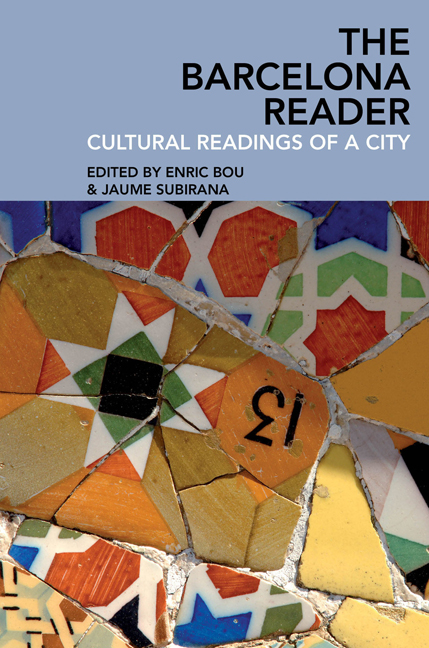Book contents
- Frontmatter
- Contents
- List of illustrations
- Notes on contributors
- Introduction: Barcelona: Cultural readings of a city
- I City, history, and territory
- II City and society
- III Art, architecture, and the city
- IV The Olympics and the city
- V Literature, cinema, and the city
- 15 La Gran Encisera: Three odes to Barcelona, and a film
- 16 The deceptive dame: Criminal revelations of the Catalan capital
16 - The deceptive dame: Criminal revelations of the Catalan capital
from V - Literature, cinema, and the city
- Frontmatter
- Contents
- List of illustrations
- Notes on contributors
- Introduction: Barcelona: Cultural readings of a city
- I City, history, and territory
- II City and society
- III Art, architecture, and the city
- IV The Olympics and the city
- V Literature, cinema, and the city
- 15 La Gran Encisera: Three odes to Barcelona, and a film
- 16 The deceptive dame: Criminal revelations of the Catalan capital
Summary
‘It is not the geography, it is not the architecture, it is not the heroes, or battles, much less so the chronicles of customs, or the fantasies conjured up by poets. No, what defines a city is the history of its crimes’, claims the narrator of Brazilian novelist Alberto Mussa's O senhor do lado esquerdo (2011: 9) [The Mystery of Rio (2013)]. While no single genre can adequately represent a city (Resina 2008: 4), Mussa's somewhat hyperbolic justification for the social importance of the crime novel is correct in so far as crimes are culturally specific, implying the transgression of a particular society's norms. However, although crimes draw our attention to a given social order, crime fiction does much more than merely represent transgression and punishment. It also ‘acts as a connective tissue within this world’ because the investigation traces ‘the hidden relationships crime both indicates and conceals, to bring to the surface, and show the way the city works’ (Messent: 1). With this in mind, the aim of this chapter is to explore the ways in which writers use crime fiction set in the Catalan capital to reveal what one character in Manuel Vázquez Montalbán's El delantero centro fue asesinado al atardecer (1988) [Offside (1995)] calls the ‘palabras que [cada época] necesita para enmascararse’ (105) [words that each era needs in order to mask itself]. The following discussion analyses both Catalan- and Castilian-language crime novels as well as works written in English, although due to space limitations only a select number of representative texts will be analysed.
In using Barcelona as a catalyst for analysis and comparison, this study eschews the usual literary categorization in the Catalan context that classifies texts according to the language in which they are written. In doing so, however, I do not want to downplay the importance of language. Indeed, it is worth pausing briefly to reflect on the politics of language and popular fiction in Catalonia before engaging with the ways in which the city comes to be revealed in crime novels. Due to several centuries of persistent, if uneven, Hispanicization from the fifteenth century to the Franco regime (1939–1975), many Catalans were illiterate in their own language, a consequence of which was the adoption of Castilian as the primary vehicle for most literary production and consumption in Catalonia.
- Type
- Chapter
- Information
- The Barcelona ReaderCultural Readings of a City, pp. 395 - 416Publisher: Liverpool University PressPrint publication year: 2017

